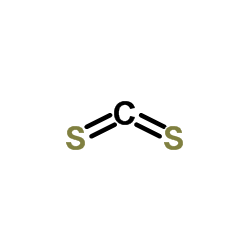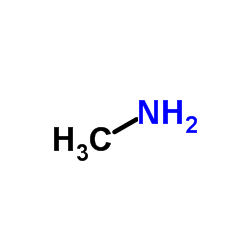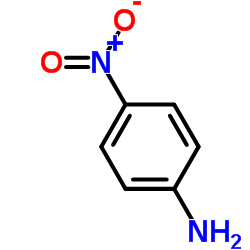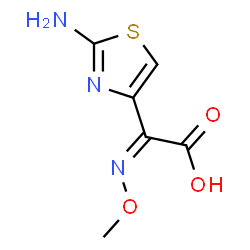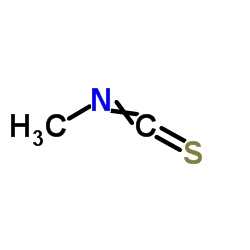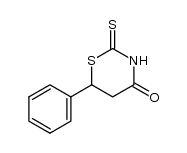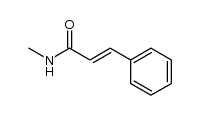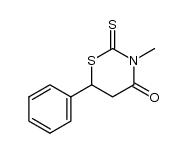137-42-8
| 中文名 | 威百亩 |
|---|---|
| 英文名 | metam-sodium |
| 中文别名 |
N-甲基二硫代氨基甲酸钠
斯美地 保丰收粉剂 |
| 英文别名 |
sodium N-methylcarbamodithioate
N-methyldithiocarbamic acid,sodium salt metam geort metham-sodium sodium N-methyl-dithiocarbamate monam sodium methylcarbamodithioate sodium methyldithiocarbamate MFCD00078694 vpm metam sodium carbam-sodium Metham sodium carbathion Basamid-fluid EINECS 205-293-0 metham vapam vdm sistan sodium methyl-dithiocarbamate SMDC |
| 描述 | 甲烷钠是一种广谱的土壤微生物抑制剂。甲烷钠可控制土壤传播的害虫和杂草。甲基苯丙胺抑制杂草种子、植物寄生线虫、植物病原真菌和土壤昆虫[1]。 |
|---|---|
| 相关类别 | |
| 参考文献 |
| 沸点 | 120.3ºC at 760mmHg |
|---|---|
| 分子式 | C2H5NNaS2 |
| 分子量 | 130.19 |
| 闪点 | 26.6ºC |
| 精确质量 | 128.96800 |
| PSA | 69.42000 |
| LogP | 1.07910 |
| 外观性状 | 橄榄色绿色至淡黄色液体,带有相当强烈的硫的气味 |
| 储存条件 | 库房通风低温干燥,与食品原料分开储运 |
| 水溶解性 | 72.2 g/100 mL at 20 ºC |
| 计算化学 | 1.疏水参数计算参考值(XlogP):无 2.氢键供体数量:1 3.氢键受体数量:2 4.可旋转化学键数量:0 5.互变异构体数量:2 6.拓扑分子极性表面积45.1 7.重原子数量:6 8.表面电荷:0 9.复杂度:46.8 10.同位素原子数量:0 11.确定原子立构中心数量:0 12.不确定原子立构中心数量:0 13.确定化学键立构中心数量:0 14.不确定化学键立构中心数量:0 15.共价键单元数量:2 |
| 更多 | 1. 性状:无色结晶固体。 2. 溶解性:水722g/L(20℃),溶于甲醇,几乎不溶于其他有机溶剂。遇酸和重金属盐分解,在湿土中分解成异氰酸甲酯。雄大鼠急性经口LD50820mg/kg。 |
|
SECTION 1: Identification of the substance/mixture and of the company/undertaking Product identifiers Product name: METAM SODIUM,250MG,NEAT REACH No.: A registration number is not available for this substance as the substance or its uses are exempted from registration, the annual tonnage does not require a registration or the registration is envisaged for a later registration deadline.
CAS-No.: 137-42-8 Relevant identified uses of the substance or mixture and uses advised against Identified uses: Laboratory chemicals, Manufacture of substances SECTION 2: Hazards identification Classification of the substance or mixture Classification according to Regulation (EC) No 1272/2008 Acute toxicity, Oral (Category 4), H302 Skin corrosion (Category 1B), H314 Skin sensitisation (Category 1), H317 Acute aquatic toxicity (Category 1), H400 Chronic aquatic toxicity (Category 1), H410 For the full text of the H-Statements mentioned in this Section, see Section 16. Classification according to EU Directives 67/548/EEC or 1999/45/EC C CorrosiveR34 Xn HarmfulR22 R31 R43 N Dangerous for theR50/53 environment For the full text of the R-phrases mentioned in this Section, see Section 16. Label elements Labelling according Regulation (EC) No 1272/2008 Pictogram Signal wordDanger Hazard statement(s) H302Harmful if swallowed. H314Causes severe skin burns and eye damage. H317May cause an allergic skin reaction. H410Very toxic to aquatic life with long lasting effects. Precautionary statement(s) P273Avoid release to the environment. P280Wear protective gloves/ protective clothing/ eye protection/ face protection. P305 + P351 + P338IF IN EYES: Rinse cautiously with water for several minutes. Remove contact lenses, if present and easy to do. Continue rinsing. P310Immediately call a POISON CENTER or doctor/ physician. P501Dispose of contents/ container to an approved waste disposal plant. Supplemental Hazard information (EU) EUH031Contact with acids liberates toxic gas. Other hazards - none SECTION 3: Composition/information on ingredients Substances Formula: C2H5NS2.Na Molecular Weight: 129,18 g/mol CAS-No.: 137-42-8 EC-No.: 205-293-0 Index-No.: 006-013-00-8 Hazardous ingredients according to Regulation (EC) No 1272/2008 ComponentClassificationConcentration Metam-sodium CAS-No.137-42-8Acute Tox. 4; Skin Corr. 1B;<= 100 % EC-No.205-293-0Skin Sens. 1; Aquatic Acute 1; Index-No.006-013-00-8Aquatic Chronic 1; H314, H302, H317, H410, EUH031 Hazardous ingredients according to Directive 1999/45/EC ComponentClassificationConcentration Metam-sodium CAS-No.137-42-8C, N, R22 - R31 - R34 - R43 - <= 100 % EC-No.205-293-0R50/53 Index-No.006-013-00-8 For the full text of the H-Statements and R-Phrases mentioned in this Section, see Section 16 SECTION 4: First aid measures Description of first aid measures General advice Consult a physician. Show this safety data sheet to the doctor in attendance. If inhaled If breathed in, move person into fresh air. If not breathing, give artificial respiration. Consult a physician. In case of skin contact Take off contaminated clothing and shoes immediately. Wash off with soap and plenty of water. Take victim immediately to hospital. Consult a physician. In case of eye contact Rinse thoroughly with plenty of water for at least 15 minutes and consult a physician. If swallowed Do NOT induce vomiting. Never give anything by mouth to an unconscious person. Rinse mouth with water. Consult a physician. Most important symptoms and effects, both acute and delayed The most important known symptoms and effects are described in the labelling (see section 2.2) and/or in section 11 Indication of any immediate medical attention and special treatment needed no data available SECTION 5: Firefighting measures Extinguishing media Suitable extinguishing media Dry powder Special hazards arising from the substance or mixture Carbon oxides, nitrogen oxides (NOx), Sulphur oxides, Sodium oxides Advice for firefighters Wear self contained breathing apparatus for fire fighting if necessary. Further information no data available SECTION 6: Accidental release measures Personal precautions, protective equipment and emergency procedures Wear respiratory protection. Avoid dust formation. Avoid breathing vapours, mist or gas. Ensure adequate ventilation. Evacuate personnel to safe areas. Avoid breathing dust. For personal protection see section 8. Environmental precautions Prevent further leakage or spillage if safe to do so. Do not let product enter drains. Discharge into the environment must be avoided. Methods and materials for containment and cleaning up Pick up and arrange disposal without creating dust. Sweep up and shovel. Do not flush with water. Keep in suitable, closed containers for disposal. Reference to other sections For disposal see section 13. SECTION 7: Handling and storage Precautions for safe handling Avoid contact with skin and eyes. Avoid formation of dust and aerosols. Provide appropriate exhaust ventilation at places where dust is formed. For precautions see section 2.2. Conditions for safe storage, including any incompatibilities Store in cool place. Keep container tightly closed in a dry and well-ventilated place. Never allow product to get in contact with water during storage. Do not store near acids. Specific end use(s) Apart from the uses mentioned in section 1.2 no other specific uses are stipulated SECTION 8: Exposure controls/personal protection Control parameters Components with workplace control parameters Exposure controls Appropriate engineering controls Avoid contact with skin, eyes and clothing. Wash hands before breaks and immediately after handling the product. Personal protective equipment Eye/face protection Face shield and safety glasses Use equipment for eye protection tested and approved under appropriate government standards such as NIOSH (US) or EN 166(EU). Skin protection Handle with gloves. Gloves must be inspected prior to use. Use proper glove removal technique (without touching glove's outer surface) to avoid skin contact with this product. Dispose of contaminated gloves after use in accordance with applicable laws and good laboratory practices. Wash and dry hands. The selected protective gloves have to satisfy the specifications of EU Directive 89/686/EEC and the standard EN 374 derived from it. Body Protection Complete suit protecting against chemicals, The type of protective equipment must be selected according to the concentration and amount of the dangerous substance at the specific workplace. Respiratory protection Where risk assessment shows air-purifying respirators are appropriate use a full-face particle respirator type N100 (US) or type P3 (EN 143) respirator cartridges as a backup to engineering controls. If the respirator is the sole means of protection, use a full-face supplied air respirator. Use respirators and components tested and approved under appropriate government standards such as NIOSH (US) or CEN (EU). Control of environmental exposure Prevent further leakage or spillage if safe to do so. Do not let product enter drains. Discharge into the environment must be avoided. SECTION 9: Physical and chemical properties Information on basic physical and chemical properties a) AppearanceForm: crystalline Colour: white b) Odourno data available c) Odour Thresholdno data available d) pHno data available e) Melting point/freezingno data available point f) Initial boiling point and no data available boiling range g) Flash pointno data available h) Evapouration rateno data available i) Flammability (solid, gas) no data available j) Upper/lowerno data available flammability or explosive limits k) Vapour pressureno data available l) Vapour densityno data available m) Relative densityno data available n) Water solubilitysoluble o) Partition coefficient: n- no data available octanol/water p) Auto-ignitionno data available temperature q) Decompositionno data available temperature r) Viscosityno data available s) Explosive propertiesno data available t) Oxidizing propertiesno data available Other safety information no data available SECTION 10: Stability and reactivity Reactivity no data available Chemical stability Stable under recommended storage conditions. Possibility of hazardous reactions no data available Conditions to avoid no data available Incompatible materials acids Hazardous decomposition products Other decomposition products - no data available In the event of fire: see section 5 SECTION 11: Toxicological information Information on toxicological effects Acute toxicity LD50 Oral - rat - 450 mg/kg LD50 Dermal - rabbit - 800 mg/kg Skin corrosion/irritation no data available Serious eye damage/eye irritation no data available Respiratory or skin sensitisation Germ cell mutagenicity no data available Carcinogenicity IARC:No component of this product present at levels greater than or equal to 0.1% is identified as probable, possible or confirmed human carcinogen by IARC. Reproductive toxicity Reproductive toxicity - rat - Oral Effects on Fertility: Post-implantation mortality (e.g., dead and/or resorbed implants per total number of implants). Effects on Embryo or Fetus: Fetotoxicity (except death, e.g., stunted fetus). Effects on Embryo or Fetus: Fetal death. Developmental Toxicity - rat - Oral Effects on Embryo or Fetus: Other effects to embryo. Specific target organ toxicity - single exposure no data available Specific target organ toxicity - repeated exposure no data available Aspiration hazard no data available Additional Information RTECS: Not available SECTION 12: Ecological information Toxicity Toxicity to daphnia and LC50 - Daphnia magna (Water flea) - 0,33 mg/l - 26 h other aquatic invertebrates Persistence and degradability no data available Bioaccumulative potential no data available Mobility in soil no data available Results of PBT and vPvB assessment PBT/vPvB assessment not available as chemical safety assessment not required/not conducted Other adverse effects Very toxic to aquatic life. SECTION 13: Disposal considerations Waste treatment methods Product Offer surplus and non-recyclable solutions to a licensed disposal company. Dissolve or mix the material with a combustible solvent and burn in a chemical incinerator equipped with an afterburner and scrubber. Contaminated packaging Dispose of as unused product. SECTION 14: Transport information UN number ADR/RID: 2811IMDG: 2811IATA: 2811 UN proper shipping name ADR/RID: TOXIC SOLID, ORGANIC, N.O.S. (Metam-sodium) IMDG: TOXIC SOLID, ORGANIC, N.O.S. (Metam-sodium) IATA:Toxic solid, organic, n.o.s. (Metam-sodium) Transport hazard class(es) ADR/RID: 6.1IMDG: 6.1IATA: 6.1 Packaging group ADR/RID: IIIIMDG: IIIIATA: III Environmental hazards ADR/RID: yesIMDG Marine pollutant: yesIATA: no Special precautions for user no data available SECTION 15: Regulatory information This safety datasheet complies with the requirements of Regulation (EC) No. 1907/2006. Safety, health and environmental regulations/legislation specific for the substance or mixture no data available Chemical Safety Assessment For this product a chemical safety assessment was not carried out SECTION 16: Other information Full text of H-Statements referred to under sections 2 and 3. Acute Tox.Acute toxicity Aquatic AcuteAcute aquatic toxicity Aquatic ChronicChronic aquatic toxicity EUH031Contact with acids liberates toxic gas. H302Harmful if swallowed. H314Causes severe skin burns and eye damage. H317May cause an allergic skin reaction. H400Very toxic to aquatic life. H410Very toxic to aquatic life with long lasting effects. Full text of R-phrases referred to under sections 2 and 3 CCorrosive NDangerous for the environment R22Harmful if swallowed. R31Contact with acids liberates toxic gas. R34Causes burns. R43May cause sensitisation by skin contact. R50/53Very toxic to aquatic organisms, may cause long-term adverse effects in the aquatic environment. Further information Copyright 2014 Co. LLC. License granted to make unlimited paper copies for internal use only. The above information is believed to be correct but does not purport to be all inclusive and shall be used only as a guide. The information in this document is based on the present state of our knowledge and is applicable to the product with regard to appropriate safety precautions. It does not represent any guarantee of the properties of the product. Corporation and its Affiliates shall not be held liable for any damage resulting from handling or from contact with the above product. See and/or the reverse side of invoice or packing slip for additional terms and conditions of sale. |
CHEMICAL IDENTIFICATION
HEALTH HAZARD DATAACUTE TOXICITY DATA
|
| 危害码 (欧洲) | C:Corrosive;N:Dangerousfortheenvironment; |
|---|---|
| 风险声明 (欧洲) | R22;R31;R34;R50/53 |
| 安全声明 (欧洲) | S26-S36/37/39-S45-S60-S61 |
| 危险品运输编码 | UN 2811 |
| RTECS号 | FC2100000 |
| 包装等级 | III |
| 危险类别 | 6.1(b) |
| 海关编码 | 2930909090 |
|
~98% 
137-42-8 |
| 文献:Fishwick, Colin W. G.; Foster, Richard J.; Carr, Robin E. Tetrahedron Letters, 1995 , vol. 36, # 51 p. 9409 - 9412 |
| 上游产品 2 | |
|---|---|
| 下游产品 10 | |
| 海关编码 | 2930909090 |
|---|---|
| 中文概述 | 2930909090. 其他有机硫化合物. 增值税率:17.0%. 退税率:13.0%. 监管条件:无. 最惠国关税:6.5%. 普通关税:30.0% |
| 申报要素 | 品名, 成分含量, 用途 |
| Summary | 2930909090. other organo-sulphur compounds. VAT:17.0%. Tax rebate rate:13.0%. . MFN tariff:6.5%. General tariff:30.0% |


